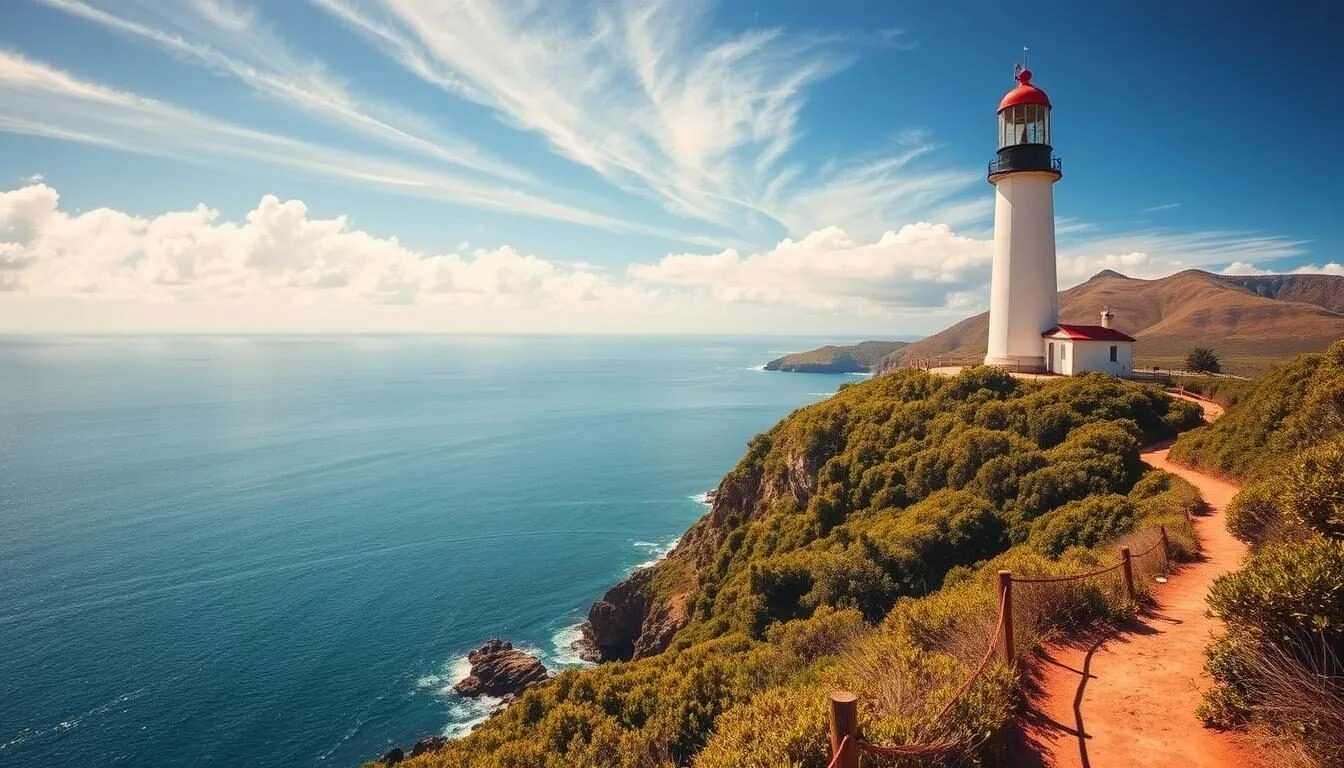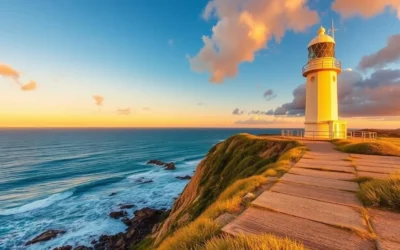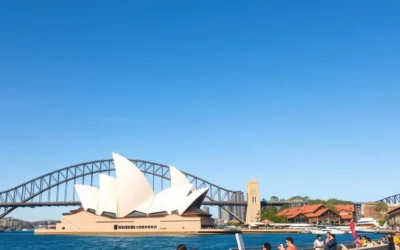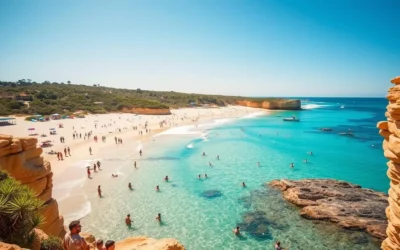✓ Accommodations✓ Flights✓ Rental Cars
Imagine standing at Australia’s most easterly point, surrounded by pristine beaches and breathtaking views. Cape Byron National Park is a haven for nature lovers and adventure seekers alike.
You can explore the park’s numerous walking tracks, encounter marine wildlife, or simply take in the stunning views from the iconic Cape Byron Lighthouse. With its rich indigenous history and cultural significance, this coastal park attracts millions of visitors each year.
As you plan your visit to Byron Bay, get ready to experience the top things to do in this beautiful national park, from sunrise lighthouse visits to whale watching and everything in between.
Discovering Cape Byron National Park
As you step into Cape Byron National Park, you’ll uncover the secrets of Australia’s most easterly point. Located in the heart of New South Wales, this park is a haven for nature lovers and those interested in exploring the rich cultural heritage of the region. Cape Byron, part of the Byron Bay area, is a significant landmark that has been a silent witness to the history and traditions of the indigenous people for thousands of years.
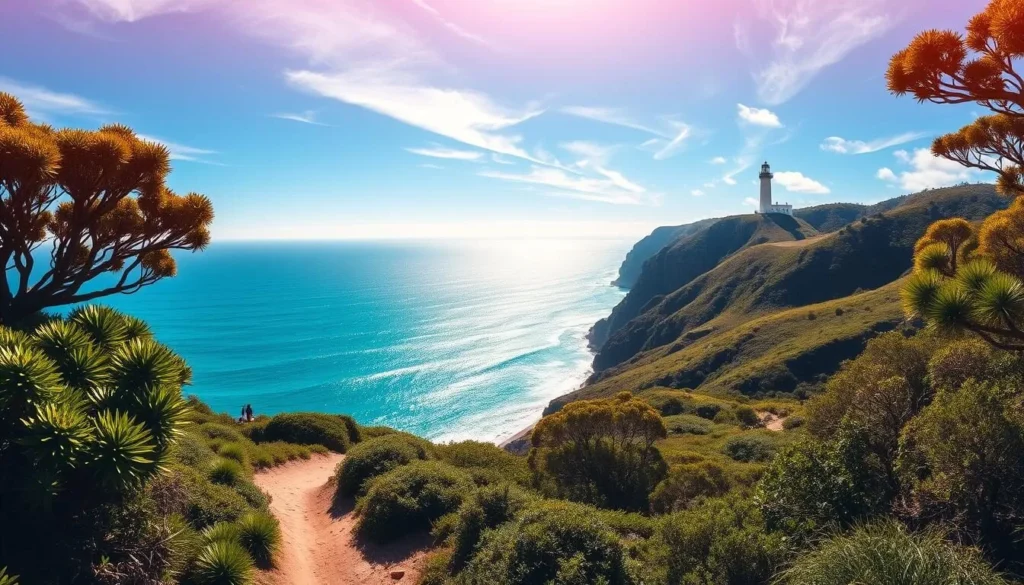
The Easternmost Point of Mainland Australia
Cape Byron is renowned for being the easternmost point of mainland Australia. This distinction makes it a unique spot for witnessing the sunrise over the Pacific Ocean. As you stand at this vantage point, you’ll be treated to breathtaking views of the coastline, stretching from the rugged cliffs to the serene beaches below. The area is not just a geographical marvel but also a spot of great spiritual significance for the indigenous Bundjalung people.
The cape’s commanding views and picturesque landscapes make it an ideal location for both relaxation and adventure. Visitors can enjoy the scenic walks, whale watching during the migration seasons, and simply soaking in the natural beauty that surrounds them. The cape’s lighthouse, a prominent feature of the park, adds to its allure, offering guided tours that delve into its history and significance.
History and Cultural Significance
Cape Byron National Park is more than just a natural wonder; it’s a place steeped in history and culture. The park has been home to the Bundjalung people for thousands of years, serving as a meeting point for ceremonies, trade, and celebrations. The indigenous Arakwal people, part of the Bundjalung Nation, are the traditional custodians of the land and have maintained their deep connection to this special place.
The area around Cape Byron, particularly the lighthouse area, was considered sacred. The men would hold important ceremonies here, drawn by the 360° views of the coast, inland, and out to sea. Today, the park is co-managed with the traditional owners, ensuring that their cultural heritage is preserved and shared with visitors. This co-management reflects a commitment to respecting and honoring the indigenous history of the area.
- Cape Byron has been home to the Bundjalung people for thousands of years, with the area holding deep spiritual significance.
- The indigenous Arakwal people, part of the Bundjalung Nation, are the traditional custodians of the land and have maintained their connection to this special place.
- For the Bundjalung people, the area around Cape Byron was a meeting place for ceremonies, trade, and celebration.
- The lighthouse area was particularly sacred, used for important men’s ceremonies due to its commanding views of the surrounding landscape.
- Today, the park is co-managed with the traditional owners, ensuring their cultural heritage is preserved and shared with visitors.
The Iconic Cape Byron Lighthouse
Byron Bay’s most iconic landmark, the Cape Byron Lighthouse, is a treasure trove of history, architecture, and natural beauty. As you visit this magnificent structure, you’ll be treated to breathtaking views of the coastline and an insight into the region’s rich maritime history.
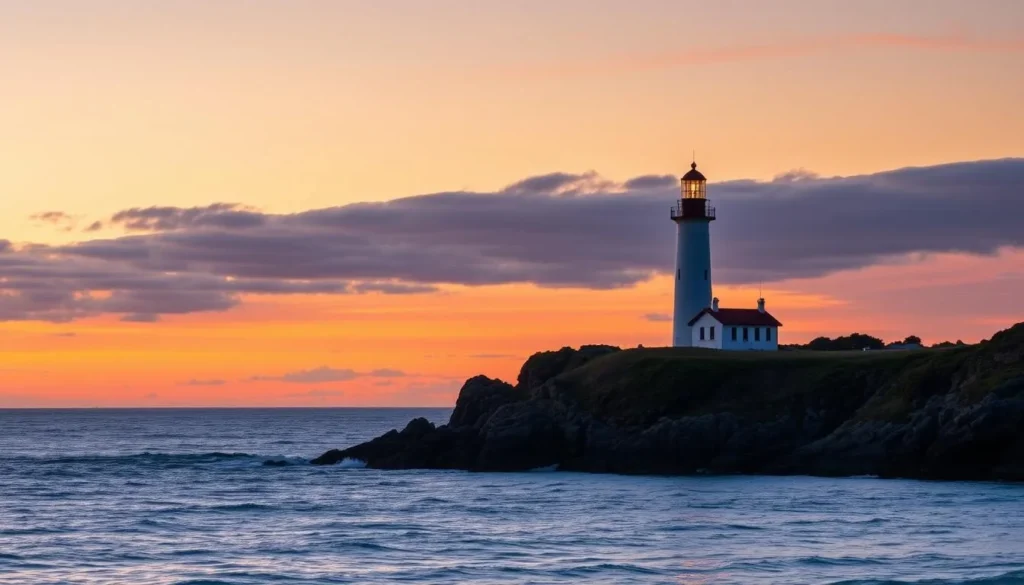
Lighthouse History and Architecture
The Cape Byron Lighthouse, built in 1901, stands as a testament to the region’s maritime significance. Its construction was crucial for guiding ships safely along the coast. The lighthouse’s architecture is characterized by its white tower, which has become an iconic symbol of Byron Bay.
Architectural Features: The lighthouse is not only a navigational aid but also a remarkable piece of architecture. Its design reflects the era’s engineering prowess and the need for a reliable beacon in the region.
Historical Significance: As the most easterly point of mainland Australia, Cape Byron and its lighthouse have played a pivotal role in the country’s maritime history, guiding countless ships and sailors.
Best Times to Visit the Lighthouse
Visiting the Cape Byron Lighthouse can be a memorable experience, especially if you time it right. Watching the sunrise over the ocean from the lighthouse is a lovely thing to do, but be prepared for company along the narrow path.
Optimal Visiting Times: Early morning or late afternoon visits are recommended to avoid the peak sun and crowds. The sunrise and sunset times offer not only comfortable temperatures but also spectacular views.
Photography Tips for the Perfect Lighthouse Shot
Capturing the perfect shot of the Cape Byron Lighthouse requires some planning. Here are some tips to help you get the best photos:
- Position yourself on the eastern side of the lighthouse during sunrise to capture the golden light illuminating the white tower against the backdrop of the ocean.
- For a classic postcard shot, head to Wategos Beach and photograph the lighthouse perched dramatically on the clifftop above.
- Use a wide-angle lens to capture both the lighthouse and the sweeping coastal views in a single frame.
- Include the winding lighthouse trail in your composition to create depth and lead the viewer’s eye toward the main subject.
- Visit during whale migration season (May-November) for the chance to capture the lighthouse with breaching whales in the foreground.
Photography Tip: Experiment with different angles and times of day to capture the unique essence of the lighthouse and its surroundings.
Cape Byron Walking Track: Australia’s Most Beautiful Coastal Walk
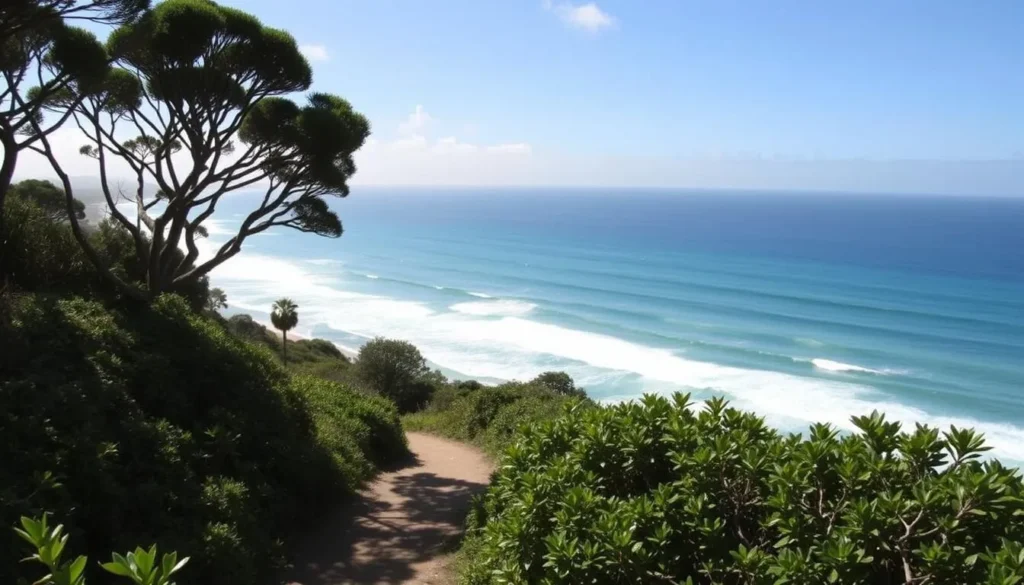
As you embark on the Cape Byron Walking Track, you’ll discover the breathtaking beauty of Australia’s most easterly coastline. This 3.7 km track is a must-visit destination for nature lovers and adventure seekers alike, offering stunning ocean views, diverse wildlife, and picturesque beaches along the way.
Route Overview and Difficulty Level
The Cape Byron Walking Track is a moderately difficult walk, suitable for most fitness levels. The track begins at the Cape Byron Lighthouse and winds its way along the coastline, passing by several scenic lookout points, beaches, and rainforest areas. The track is well-marked and well-maintained, making it easy to navigate.
As you walk along the track, you’ll pass through various vegetation zones, including coastal heath and rainforest. The diverse flora and fauna along the track make it a great spot for nature lovers and photographers.
Scenic Lookout Points Along the Track
One of the highlights of the Cape Byron Walking Track is the numerous scenic lookout points along the way. These lookouts offer breathtaking views of the ocean, coastline, and surrounding landscape. Some of the most popular lookout points include the Cape Byron Lighthouse lookout, Wategos Beach lookout, and the lookout near the most easterly point of mainland Australia.
Keep your eyes on the ocean as you walk, and you may spot bottlenose dolphins playing in the waves below. During winter months (May-November), the track provides excellent vantage points for whale watching as humpbacks migrate along the coast.
Flora and Fauna to Spot Along the Way
The Cape Byron Walking Track is home to a diverse range of flora and fauna. The coastal heath sections of the track are home to a variety of native birds, including sea eagles, ospreys, and the distinctive brahminy kite with its striking white head.
In the rainforest sections, watch for brush turkeys scratching through the undergrowth and listen for the calls of whipbirds and figbirds. The diverse vegetation zones along the track showcase coastal banksia, pandanus palms, and rainforest species, with informative signs identifying key plant species and their traditional uses by Aboriginal people.
As you explore the Cape Byron Walking Track, you’ll have the opportunity to see bottlenose dolphins and three types of sea turtles that live in the clear waters off the coast. With its stunning natural beauty and diverse wildlife, this track is a must-visit destination for anyone traveling to Byron Bay.
Beach Hopping Around Cape Byron National Park
As you explore Cape Byron National Park, you’ll discover a string of stunning beaches, each with its own unique charm. The park’s diverse coastline offers a range of experiences, from the bustling atmosphere of Main Beach to the secluded tranquility of Belongil Beach.
Main Beach: The Heart of Byron Bay
Main Beach is the epicenter of Byron Bay’s social scene, with a wide stretch of sand that’s perfect for sunbathing, swimming, and surfing. The beach is lined with cafes, restaurants, and shops, making it a great spot to spend the day. You can also take a surfing lesson or rent a paddleboard to explore the coastline.
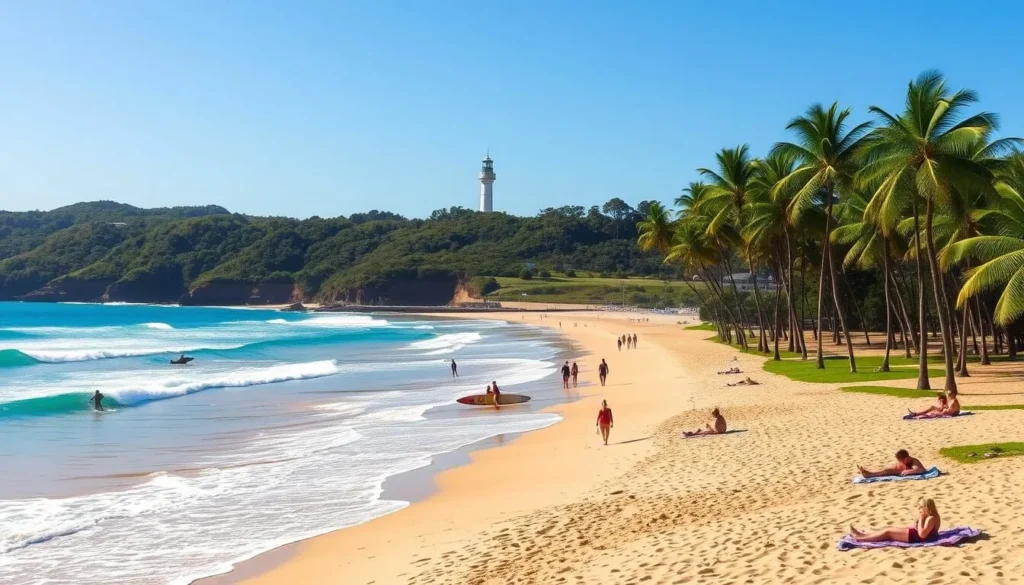
Wategos Beach: A Sheltered Paradise
Wategos Beach is a secluded haven located just north of Cape Byron. This picturesque beach is surrounded by rocky outcrops and offers crystal-clear waters perfect for swimming and snorkeling. The beach is accessible via a short walk from the Cape Byron walking track, making it a great spot to take a break and enjoy the scenery.
Tallow Beach: Pristine Stretches of Sand
Tallow Beach is a 9km stretch of sand that extends north from Byron Bay, offering a more secluded alternative to Main Beach. The beach is backed by coastal dunes and vegetation, creating a natural and peaceful atmosphere. You can drive along the beach, go for a hike, or simply relax and enjoy the scenery.
Belongil Beach: Secluded Coastal Beauty
Belongil Beach is a beautiful secluded stretch of sand that extends 2.5 km north from the seawall at Main Beach to Belongil Creek. The beach is backed by coastal dunes and vegetation, creating a more natural and secluded atmosphere. There’s a designated clothing-optional area at the northern end of the beach, and it takes around 10 minutes to walk there along the beach.
| Beach | Main Features | Activities |
|---|---|---|
| Main Beach | Bustling atmosphere, wide stretch of sand | Surfing, swimming, sunbathing |
| Wategos Beach | Secluded, crystal-clear waters | Swimming, snorkeling |
| Tallow Beach | Pristine, 9km stretch of sand | Hiking, driving, relaxing |
| Belongil Beach | Secluded, natural atmosphere | Swimming, walking, relaxing |
Marine Wildlife Encounters in Cape Byron

The waters around Cape Byron are teeming with life, making it a paradise for marine wildlife enthusiasts. As you explore this beautiful region, you’ll have the opportunity to encounter an incredible array of marine animals in their natural habitat.
Whale Watching Opportunities
Cape Byron is renowned for its whale watching tours, offering a chance to witness these majestic creatures up close. During the migration seasons, humpback whales can be seen breaching and playing in the waters around Cape Byron. Byron Bay is one of the best places in Australia to watch these gentle giants.
The whale watching season typically runs from May to November, with peak months being July to October. You can take a guided tour with experienced operators who provide insightful commentary on these magnificent creatures and their habitat.
Dolphin Spotting Adventures
Dolphin spotting is another thrilling experience you can have in the waters around Cape Byron. Bottlenose and common dolphins are frequently seen in the area, often swimming alongside boats or playing in the waves. A surfing or swimming spot can quickly turn into a dolphin-watching adventure.
For the best dolphin spotting opportunities, consider taking a guided boat tour that focuses on marine wildlife. These tours often venture into the sea areas where dolphins are known to frequent, providing a closer look at these intelligent and social creatures.
Sea Turtle and Marine Life Experiences
The Julian Rocks Marine Reserve, just a short boat ride from Cape Byron, is home to an incredible array of marine life, including three species of sea turtles: green, loggerhead, and hawksbill. You can snorkel or dive among these gentle creatures in their natural habitat.
On a snorkel tour, you can swim with sea turtles, Manta Rays, and Leopard sharks in the marine sanctuary at Julian Rocks. The waters around Cape Byron support over 500 species of fish and marine invertebrates, creating one of the most biodiverse marine environments on Australia’s east coast. Visiting the nearby beaches, such as Wategos or Tallow Beach, you can enjoy the serene beauty of the coastline while knowing that the marine life is thriving just offshore.
Water Activities for Every Adventure Level
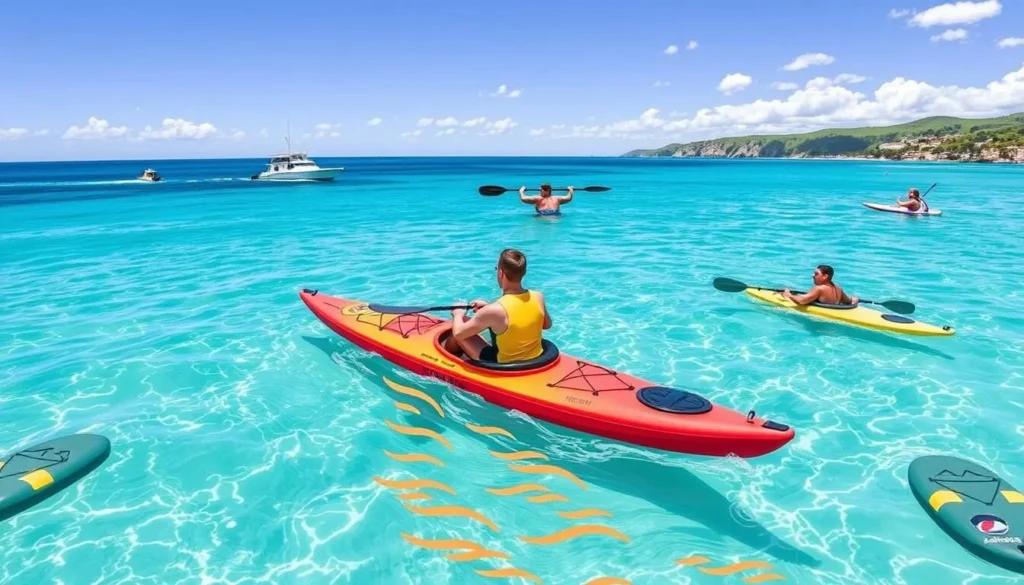
The waters around Cape Byron National Park are a playground for those seeking adventure and tranquility. Whether you’re an adrenaline junkie or looking for a relaxing experience, the area offers a diverse range of water activities that cater to all levels of enthusiasm and skill.
Surfing the Legendary Byron Bay Breaks
Byron Bay is renowned for its world-class surfing conditions. The bay’s consistent waves make it an ideal spot for both beginners and experienced surfers. You can take a surfing lesson with one of the local instructors to learn the best techniques and catch some of the legendary Byron Bay breaks.
The area is home to several surf schools that offer lessons for all skill levels. They provide equipment rentals and guided sessions to help you make the most of your surfing experience. Whether you’re looking to ride the waves or simply enjoy the ocean views, Byron Bay’s surf scene is not to be missed.
Kayaking with Marine Wildlife
Kayaking is a fantastic way to explore the coastline of Cape Byron National Park while getting up close to the marine wildlife. You can paddle through calm waters and observe the rich biodiversity of the area, including dolphins, turtles, and various bird species.
Guided kayaking tours are available, offering a safe and informative experience. These tours often include stops at secluded beaches and provide insights into the local ecosystem. It’s a great way to enjoy the natural beauty of the area while engaging in a fun and environmentally friendly activity.
Snorkeling and Diving at Julian Rocks
Julian Rocks Marine Reserve, located just off the coast of Cape Byron, is a haven for snorkeling and diving enthusiasts. The reserve is known for its incredible biodiversity, with over 1,000 marine species recorded, including sea turtles, rays, and colorful fish.
Snorkeling tours allow you to explore the shallow waters and observe the marine life without needing extensive diving certification. For certified divers, the area offers deeper dive sites with depths ranging from 6 to 24 meters, providing an exciting experience exploring the underwater world.
The best time for snorkeling and diving at Julian Rocks varies, with winter months offering clearer waters and summer bringing an influx of tropical species. This makes the location appealing throughout the year, depending on your preferences.
Cape Byron National Park, New South Wales: Best Things to Do for Nature Lovers
As a nature lover, you’ll find Cape Byron National Park to be a haven for diverse wildlife and ecosystems. The park offers a range of experiences that allow you to connect with nature, from birdwatching to exploring the native plant species and rainforest areas.
Birdwatching Hotspots
Cape Byron National Park is a paradise for birdwatchers, with its diverse habitats supporting a wide range of bird species. As you walk through the park, you’ll have the opportunity to spot some of Australia’s most unique and colorful birds.
The park’s varied landscapes, from coastal woodlands to rainforests, provide a home for over 100 species of birds. You can expect to see birds such as the Azure Kingfisher, Rainbow Lorikeet, and Brahminy Kite. The best time for birdwatching is early in the morning or during the late afternoon when the birds are most active.
Some of the top birdwatching hotspots in the park include the Palm Valley area, where you can see a variety of birds among the towering bangalow palms, and the coastal banksia woodlands, which are home to nectar-feeding birds.

Native Plant Species and Rainforest Areas
The Cape Byron National Park is not just a haven for birds; it’s also home to a rich variety of native plant species and rainforest areas. The park preserves several distinct plant communities, including littoral rainforest, one of Australia’s most endangered ecosystems.
The Palm Valley area features remnant subtropical rainforest with towering bangalow palms, strangler figs, and a diverse understory of native plants. This area is a must-visit for anyone interested in botany or looking to experience the beauty of a subtropical rainforest.
The park is also home to coastal banksia woodlands, which dominate the headland areas and provide important habitat for nectar-feeding birds and small mammals. Many plants within the park have traditional uses by the Bundjalung people, including the spiky-leaved pandanus for weaving and the native raspberry as bush food.
Guided botanical walks are available through the park, highlighting the medicinal and food plants that have sustained indigenous communities for thousands of years. These walks offer a unique opportunity to learn about the park’s flora and its significance to the local Aboriginal culture.
As you explore the park, you’ll discover the wealth of native trees and plants that the Aboriginal people have used as “bush tucker” and medicine for centuries. The park’s diverse ecosystems make it a fascinating place to visit for nature lovers and those interested in learning about the local flora and its cultural significance.
Aboriginal Cultural Experiences in the Park
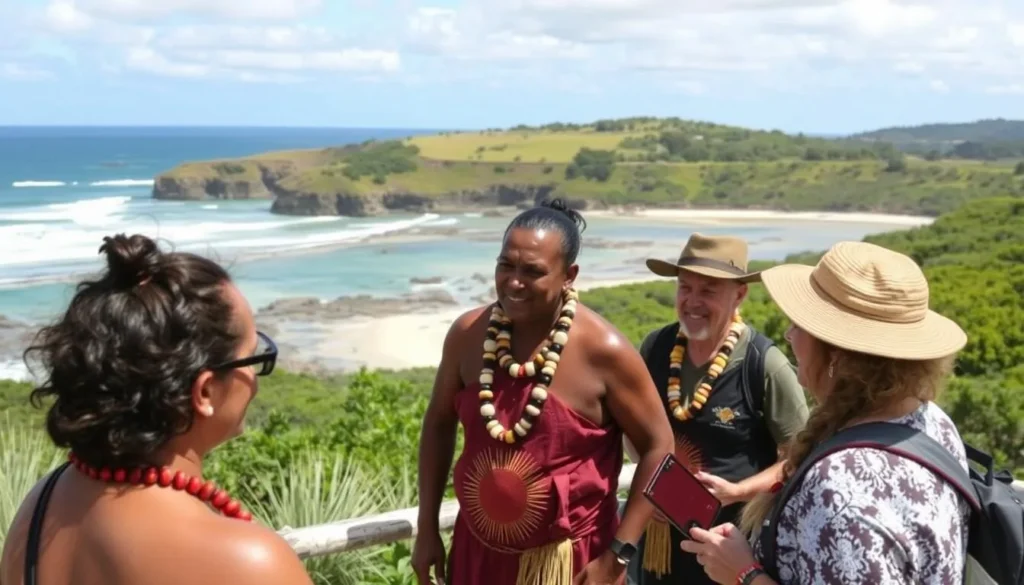
The Aboriginal cultural tours in Byron Bay offer a unique lens through which to explore Cape Byron National Park. As you journey through this beautiful region, you’ll have the opportunity to connect with the land’s original custodians and gain a deeper understanding of their culture and traditions.
Cape Byron National Park is not just a haven for nature lovers; it’s also a place where the rich history and culture of the Aboriginal people come alive. The park is home to the Arakwal people, who have lived in harmony with the land for thousands of years. Their stories, traditions, and connection to the land are an integral part of the park’s identity.
Arakwal People’s Connection to the Land
The Arakwal people’s connection to the land is profound and multifaceted. Their relationship with the natural environment is rooted in a deep understanding of the local flora and fauna, as well as the spiritual significance of various sites within the park. As you explore the park, you’ll have the chance to learn about the Arakwal people’s traditional practices and the ways in which they have managed the land sustainably over generations.
The Arakwal people have a rich cultural heritage, with stories and traditions passed down through generations. Their Dreamtime stories explain the creation of significant landmarks within the park, including Cape Byron itself. These stories are not just mere legends; they are an integral part of the Arakwal people’s identity and their connection to the land.
By engaging with the Aboriginal cultural experiences in the park, you’ll gain a deeper appreciation for the Arakwal people’s way of life and their enduring connection to this beautiful region. You’ll have the opportunity to learn about traditional hunting and gathering techniques, tool making, and the sophisticated resource management practices that allowed the Arakwal people to thrive in harmony with the environment.
Guided Indigenous Cultural Tours
Guided Indigenous cultural tours are an excellent way to experience the rich cultural heritage of Cape Byron National Park. Led by knowledgeable Arakwal guides, these tours offer a unique opportunity to explore the park through the eyes of its traditional custodians. You’ll visit significant sites, learn about the local flora and fauna, and gain insights into the Arakwal people’s traditional practices and way of life.
During the tour, you’ll have the chance to participate in bush food demonstrations, identifying edible plants that have sustained the Arakwal people for thousands of years. You’ll also learn about the traditional techniques used by the Arakwal people to manage the land and their resources. These experiences will provide a deeper understanding of the Arakwal people’s connection to the land and their rich cultural heritage.
By joining a guided Indigenous cultural tour, you’ll not only gain a new perspective on Cape Byron National Park, but you’ll also be supporting the local Aboriginal community. These tours provide economic opportunities for Indigenous community members while promoting cross-cultural understanding and appreciation of Australia’s first peoples.
As you visit Byron Bay and explore Cape Byron National Park, take the time to engage with the Aboriginal cultural experiences available. You’ll leave with a newfound appreciation for the land, its people, and their rich cultural heritage.
Best Sunrise and Sunset Viewing Locations
The most easterly point of Australia, Cape Byron, is where you can watch the sunrise over the ocean in all its glory. As the day begins, the sky transforms into a kaleidoscope of colors, a breathtaking spectacle that draws visitors from around the world.
Dawn at Australia’s Most Easterly Point
Watching the sunrise from the tip of Cape Byron is an experience you won’t soon forget. The Cape Byron Lighthouse, standing tall at this easternmost point, is the perfect vantage point to witness the dawn break. As the sun rises, the light dances across the waves, creating a mesmerizing display of nature’s beauty.
While the narrow path to the lighthouse can get crowded, the tranquility of the moment makes it well worth the visit. The sound of the waves gently lapping against the shore, combined with the warmth of the rising sun, creates a serene atmosphere that is truly unforgettable.
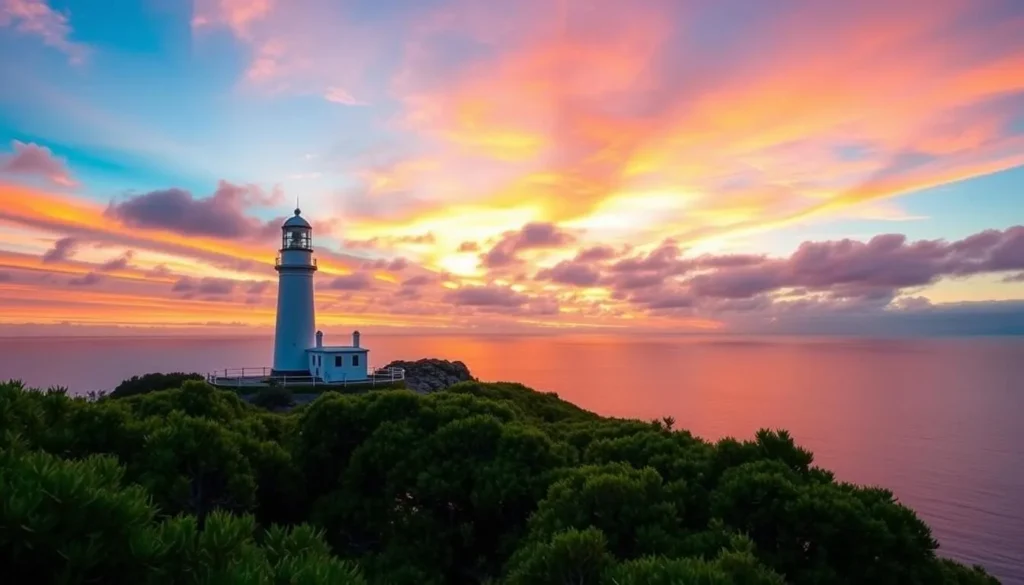
As you stand at the edge of the continent, the vast expanse of the Pacific Ocean stretches out before you, a sight that fills the heart with wonder and awe. It’s a moment of pure connection with nature, a reminder of the beauty that our world has to offer.
Evening Magic from Cape Byron’s Lookouts
While Cape Byron is renowned for its sunrises, the evening light here is equally enchanting. As the day comes to a close, the lookouts around Cape Byron offer stunning views of the sunset. The Cape Byron Lighthouse, bathed in the golden light of the late afternoon, becomes an even more picturesque subject against the backdrop of a deepening blue sky.
Fisherman’s Lookout is another vantage point that offers breathtaking views of the sunset. Here, you can watch surfers catching the last waves of the day as the sun dips behind the hinterland mountains, a scene that combines the thrill of the ocean with the tranquility of the evening.
The western side of the Cape Byron Walking Track provides additional viewpoints where you can observe the sunset colors reflecting on the ocean and the lighthouse. These moments of natural beauty are made even more special by the relative serenity of the evening hours, with fewer crowds than at sunrise, allowing for a more contemplative experience.
As the sun dips below the horizon, the sky is painted with hues of orange, pink, and purple, a final flourish to a day spent exploring Cape Byron. It’s a reminder that every moment here is a blend of natural beauty and unforgettable experiences.
Exploring the Byron Bay Hinterland from Cape Byron
Discover the hidden gems of the Byron Bay hinterland, where nature’s splendor and local culture blend seamlessly. The hinterland offers a diverse range of experiences, from breathtaking natural wonders to charming towns filled with character.

Minyon Falls and Nightcap National Park
One of the crown jewels of the Byron Bay hinterland is the Minyon Falls, a stunning 100-meter waterfall surrounded by lush rainforest. The falls are accessible via a scenic walking track that winds through the Nightcap National Park, offering breathtaking views and opportunities to spot local wildlife.
The Nightcap National Park is a haven for nature lovers, with its diverse flora and fauna. As you walk through the park, you’ll be surrounded by the sounds of birdsong and the rustling of leaves, creating a truly immersive experience.
Charming Hinterland Towns Worth Visiting
The Byron Bay hinterland is dotted with charming towns, each with its own unique character. Bangalow, just 15 minutes from Cape Byron, charms visitors with its heritage-listed main street lined with Federation-style buildings housing artisan shops, galleries, and acclaimed restaurants.
Mullumbimby, known as the “Biggest Little Town in Australia,” offers a more authentic alternative to Byron Bay with its vibrant farmers’ market and artistic atmosphere. Other towns worth visiting include Federal, with its award-winning Japanese restaurant, and Brunswick Heads, with its nostalgic seaside village experience.
Newrybar, one of the region’s oldest settlements, features the historic Harvest restaurant and deli complex, where you can sample local produce in buildings dating back to the 1900s. Nimbin, about an hour from Byron Bay, is known as the hippy capital of New South Wales, offering a fun and alternative culture experience.
Each of these towns provides a unique glimpse into the region’s history, culture, and natural beauty, making them must-visit destinations on your Byron Bay itinerary.
Best Food and Drink Near Cape Byron National Park
The area around Cape Byron National Park is dotted with exceptional restaurants and cafes that offer a taste of the region’s unique flavors. Whether you’re looking for a casual meal or a more sophisticated dining experience, Byron Bay has something to offer.
Beachside Cafés and Coffee Spots
Byron Bay is renowned for its beautiful beaches, and the cafes along these beaches are just as impressive. You can start your day with a cup of coffee at one of the many beachside cafes. The Saltwater Café is a popular spot, offering delicious breakfast options and stunning views of the ocean.
Another great option is the Byron Bay Coffee Company, known for its high-quality coffee and relaxed atmosphere. It’s the perfect place to grab a coffee and pastry before heading out to explore Cape Byron National Park.
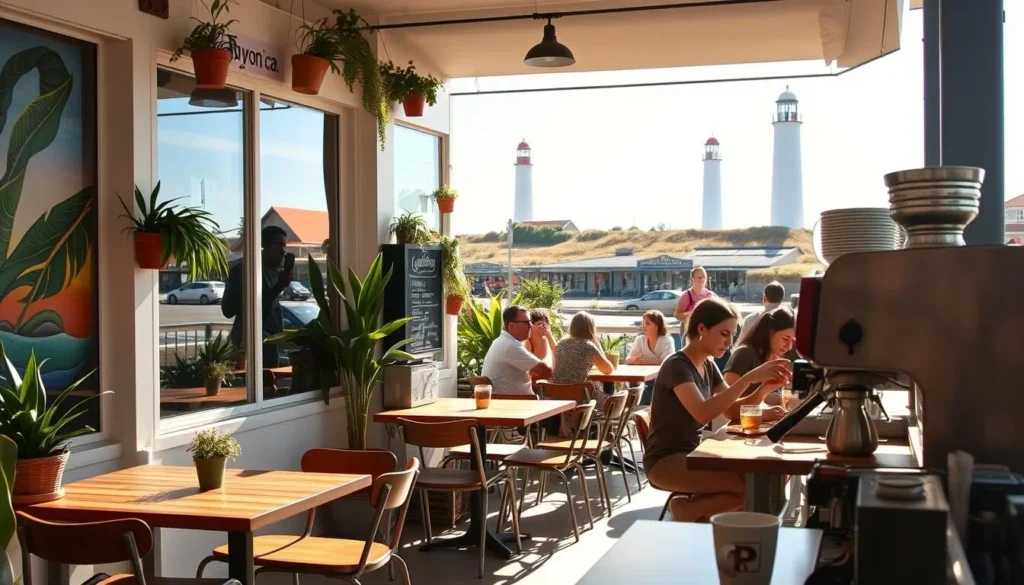
Local Restaurants with Ocean Views
For those looking to enjoy a meal with a view, Byron Bay has several restaurants that offer stunning ocean vistas. The Beach Hotel, known locally as “The Beachy,” has multiple bars and restaurants, one of which serves contemporary Australian cuisine with a focus on seasonal ingredients.
Another excellent choice is the Balcony Bar, which not only serves an impressive selection of local and international craft beers but also offers cocktails and wine. Its elevated position provides views over the main street and toward the ocean, making it a great spot to relax and enjoy a meal.
| Restaurant | Cuisine | View |
|---|---|---|
| The Beach Hotel | Contemporary Australian | Ocean views |
| Balcony Bar | International/Craft Beer | Main street and ocean views |
| Rails | Pub food | Historic railway station setting |
Byron Bay’s Craft Breweries and Bars
Byron Bay is also a haven for craft beer enthusiasts. Stone & Wood Brewing Co, Byron Bay’s most famous brewery, offers tours and tastings of their acclaimed Pacific Ale and other craft beers. You can book a tour in advance, as they tend to sell out quickly.
The Byron Bay Brewery, located within the Arts Factory complex, combines craft beer production with live music events, creating a vibrant atmosphere to enjoy their range of locally brewed beers. It’s a unique experience that blends music, beer, and art.
For a more traditional pub experience, The Rails, housed in the old railway station, offers a selection of craft beers on tap accompanied by live music seven nights a week. It’s a great place to enjoy a cold beer in an authentic Byron Bay setting.
Where to Stay Near Cape Byron National Park
Cape Byron National Park offers a diverse range of accommodations to suit every traveler’s needs, from luxury to budget-friendly options. Whether you’re looking to relax in style or enjoy the great outdoors, you’ll find the perfect place to stay near Cape Byron.
Luxury Accommodations with Ocean Views
For those seeking a luxurious getaway, there are several high-end accommodations near Cape Byron National Park that offer stunning ocean views. These resorts and hotels provide top-notch amenities and services, ensuring a comfortable and memorable stay.
One such luxury accommodation is the Byron at Byron Resort & Spa, which offers elegant rooms and suites with private balconies overlooking the ocean. Guests can enjoy fine dining, a relaxing spa, and personalized service.
Another option is the Elements of Byron, a luxury eco-apartments resort that features spacious accommodations with kitchenettes and breathtaking views of the coastline.
Mid-Range Options for Families
Families will find a variety of mid-range accommodations near Cape Byron National Park that offer a great balance of comfort and affordability. These options include self-contained apartments, bed-and-breakfasts, and holiday parks.
The Byron Bay YHA is a great choice for families, offering affordable accommodation options, a swimming pool, and a communal kitchen. It’s located in the heart of Byron Bay, just a short walk from the beach.
Another family-friendly option is the First Sun Holiday Park, which provides a range of accommodations from camping sites to self-contained cabins. The park is situated near Main Beach and offers direct access to town amenities.
Budget-Friendly Stays for Backpackers
Backpackers and budget travelers will find several affordable accommodation options near Cape Byron National Park. These include hostels, guesthouses, and camping grounds that offer a social atmosphere and basic amenities.
The Arts Factory Lodge is a popular choice among backpackers, offering unique accommodation options ranging from dormitories to teepees and jungle camping. It’s set within a creative community just outside the town center.
Another budget-friendly option is the Nomads Byron Bay, which provides hostel-style accommodation with a pool, outdoor areas, and organized activities. It’s perfect for solo travelers looking to meet other backpackers.
Seasonal Events and Festivals Around Cape Byron

From summer music festivals to winter whale watching, Cape Byron’s events calendar is as vibrant as its landscapes. The area around Cape Byron National Park is known for its lively cultural scene, with events that celebrate its natural beauty, rich history, and diverse wildlife.
Summer Music and Arts Festivals
Summer is a peak season for music and arts festivals in and around Byron Bay. The Byron Bay Bluesfest is one of the most popular events, attracting visitors from all over the world. This festival celebrates all genres of music, with a focus on blues, roots, and indie music.
Another significant event is the Byron Bay Writers Festival, which brings together authors, poets, and journalists for a series of workshops, panel discussions, and readings. It’s a paradise for literature lovers and those looking to be inspired by the creative community.
The Byron Bay Arts and Music Festival also takes place during the summer, featuring local artists, live music, and performances that showcase the region’s vibrant cultural scene.
Winter Whale Watching Season Events
Winter months, from May to November, mark the whale watching season in Byron Bay, with humpback whales migrating past the coast. The Cape Byron Whale Watching Festival in June is a highlight, marking the beginning of the migration season with guided walks, educational talks, and special lighthouse tours focused on marine conservation.
Winter Whale Watching Tours operate daily from June to November, with increased departures during peak migration periods in July and September. Sightings are almost guaranteed during these times, making it a thrilling experience for visitors.
The Winter Solstice Whale Ceremony is another unique event, honoring the traditional connection between the Bundjalung people and the migrating whales. It’s a collaboration between local indigenous elders and conservation groups, adding a cultural depth to the whale watching experience.
For photography enthusiasts, there are workshops specifically focused on capturing whales from the Cape Byron headland, led by professional wildlife photographers. The annual Whale Song Concert at the lighthouse combines live acoustic music with the natural sounds of whale calls, creating a unique celebration of these marine mammals.
Practical Tips for Visiting Cape Byron National Park
When planning your trip to Cape Byron National Park, there are several practical considerations to keep in mind. To ensure a smooth and enjoyable experience, it’s crucial to be aware of the best times to visit, how to get around, and the costs associated with your trip.
Best Time of Year to Visit
The best time to visit Cape Byron National Park is during the spring and autumn months when the weather is mild and ideal for outdoor activities. Spring (September to November) and autumn (March to May) offer pleasant temperatures, ranging from 15°C to 25°C (59°F to 77°F), making it perfect for hiking, whale watching, and exploring the park’s scenic lookouts. Summer can be quite crowded, while winters are generally cooler and quieter.
If you’re interested in whale watching, the season typically runs from May to November, with peak months being July to October. Dolphins can be spotted throughout the year, making Cape Byron a great destination for marine wildlife enthusiasts.
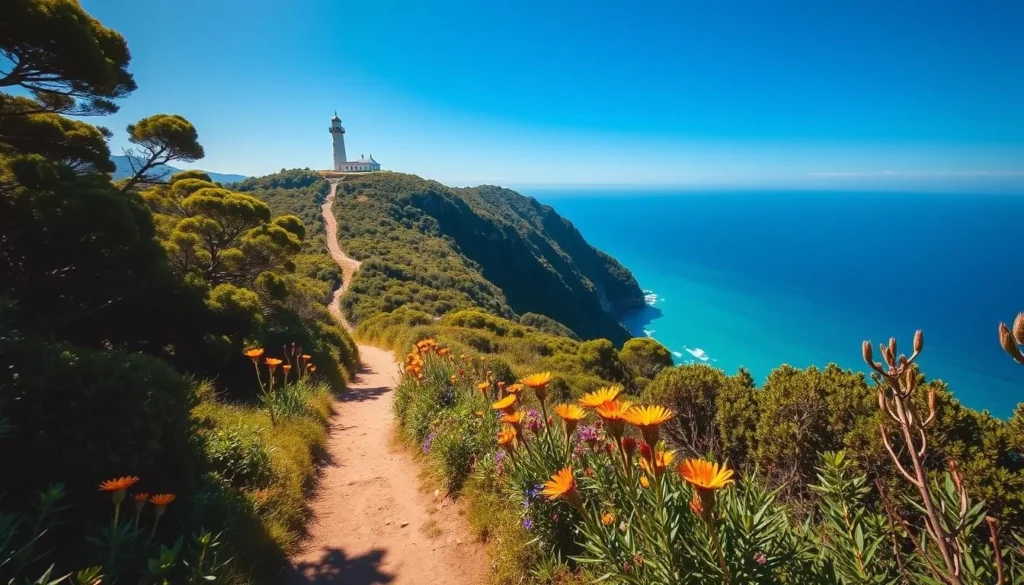
Parking and Transportation Options
Cape Byron National Park is easily accessible by car, with several parking areas throughout the park. Parking fees apply at most car parks, with revenue contributing to conservation efforts and facility maintenance. Visitors can also use public transportation or join guided tours that include transportation from nearby towns like Byron Bay.
For those who prefer to cycle, there are bike racks available near some of the park’s main attractions. However, be aware that some areas may have restricted access for bicycles or vehicles.
- Main car parks are located near the Cape Byron Lighthouse and at various lookouts and beaches.
- Public buses operate from Byron Bay to the park, offering a convenient alternative to driving.
- Guided tours often include transportation and can provide a hassle-free way to explore the park.
Park Fees and Conservation Efforts
Entry to Cape Byron National Park is free, but parking fees apply throughout the park. The revenue generated from parking fees is used directly for conservation efforts and maintaining park facilities. The park is jointly managed by the NSW National Parks and Wildlife Service and the Bundjalung of Byron Bay Aboriginal Corporation (Arakwal), setting a precedent for indigenous co-management of protected areas.
Visitors can contribute to conservation efforts by respecting wildlife, staying on designated tracks, properly disposing of waste, and participating in volunteer programs such as beach clean-ups. The Cape Byron Marine Park complements the terrestrial protected area, with zoning regulations in place to protect marine habitats while allowing for sustainable recreational activities.
By being mindful of your impact and supporting conservation initiatives, you can help preserve the natural beauty of Cape Byron National Park for future generations.
Day Trip Itineraries from Cape Byron
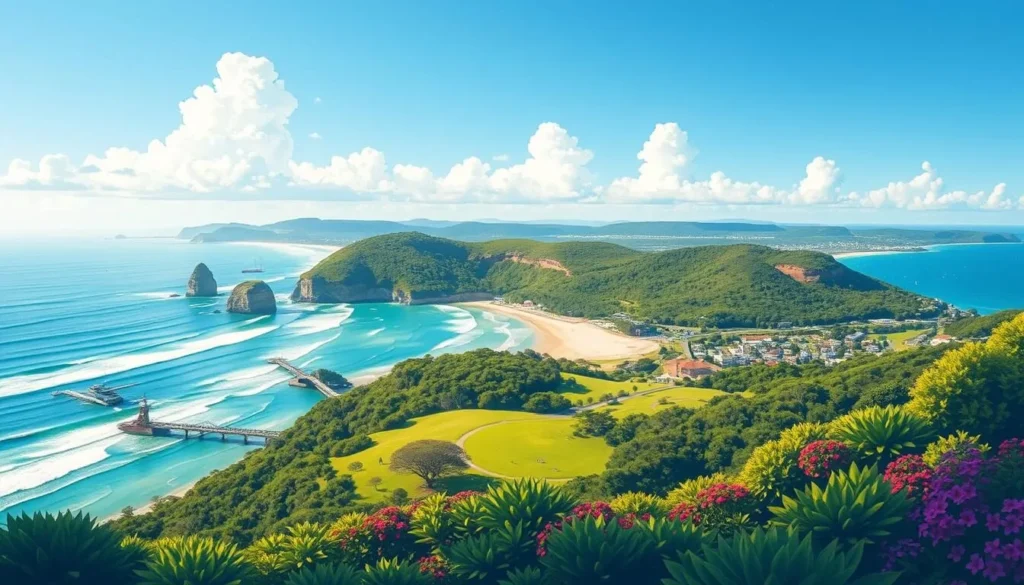
Unleash your sense of adventure with our curated day trip itineraries from Byron Bay. Whether you’re looking for a relaxing day by the beach or an action-packed adventure, we’ve got you covered.
Family-Friendly Day Plan
A day trip around Byron Bay can be a fun and memorable experience for the whole family. Start your day with a sunrise hike along the Cape Byron Walking Track, beginning at Wategos Beach. Time your arrival at the Most Easterly Point to coincide with the first light breaking over the Pacific Ocean.
After witnessing the breathtaking sunrise, head to The Pass for a morning surf session. With board rentals available, you don’t need to bring your own to catch some waves at one of Australia’s most renowned point breaks.
As the day progresses, take a guided snorkeling or diving tour to Julian Rocks Marine Reserve. Here, you’ll encounter an array of marine life, including sea turtles and rays, in a vibrant underwater world.
Adventure Seeker’s Itinerary
For those seeking adrenaline-pumping activities, Byron Bay offers a plethora of options. Begin your day with a thrilling mountain biking adventure in the nearby hinterland trails. With bike rentals and guided tours available from operators in Byron Bay, you’re all set for an exhilarating ride.
After working up an appetite, grab a bite to eat at one of the local eateries, offering a range of delicious cuisine. Then, cap off your day with a sunset paragliding experience from the hills behind Byron Bay. Soar over the coastline and enjoy panoramic views of Cape Byron and the surrounding landscape.
Both itineraries offer a unique perspective on Byron Bay, showcasing its natural beauty and adventure opportunities. Whether you’re traveling with family or seeking thrills, Byron Bay is a destination that promises an unforgettable day trip experience.
As you plan your visit to Byron Bay, consider the best times to enjoy these activities. The region’s mild climate means that there’s never a bad time to visit, but certain activities are seasonal. For instance, whale watching is a highlight during the winter months, while the summer is perfect for surfing and beach activities.
Conclusion: Why Cape Byron National Park Should Be on Your Bucket List
Nestled at Australia’s most easterly point, Cape Byron National Park is a haven for those seeking adventure and serenity. This park is more than just a natural wonder; it’s an experience that combines stunning landscapes, rich cultural heritage, and diverse activities that cater to all kinds of travelers.
One of the standout features of Cape Byron National Park is its unique geographical position, which not only provides breathtaking views but also creates a special sense of place that visitors cherish long after they’ve left. The park’s diverse ecosystems, ranging from pristine beaches and marine sanctuaries to littoral rainforests and coastal heathlands, offer a rare opportunity to experience a wide range of natural beauty within a relatively small area.
The co-management of the park by its traditional owners, the Arakwal people, ensures that visitors can enjoy authentic indigenous cultural perspectives alongside the natural attractions. This blend of nature and culture makes Byron Bay a truly unique destination. Whether you’re looking to relax on the beach, engage in water activities, or explore the local culture, Cape Byron has something for everyone.
Visitors to the park can enjoy a variety of experiences, from whale watching and dolphin spotting to exploring the historic lighthouse. The park’s beaches, such as Main Beach, Wategos Beach, and Tallow Beach, offer serene spots for relaxation and enjoyment. Moreover, the opportunity to visit Byron Bay and explore its surroundings makes for a well-rounded travel experience.
In conclusion, Cape Byron National Park is a must-visit place that promises an unforgettable experience. With its natural beauty, cultural significance, and diverse activities, it’s an ideal destination for travelers from around the world, especially those from the United States looking for a unique getaway. So, plan your visit to Byron Bay and discover the magic of Cape Byron at the right time.
The above is subject to change.
Check back often to TRAVEL.COM for the latest travel tips and deals.
